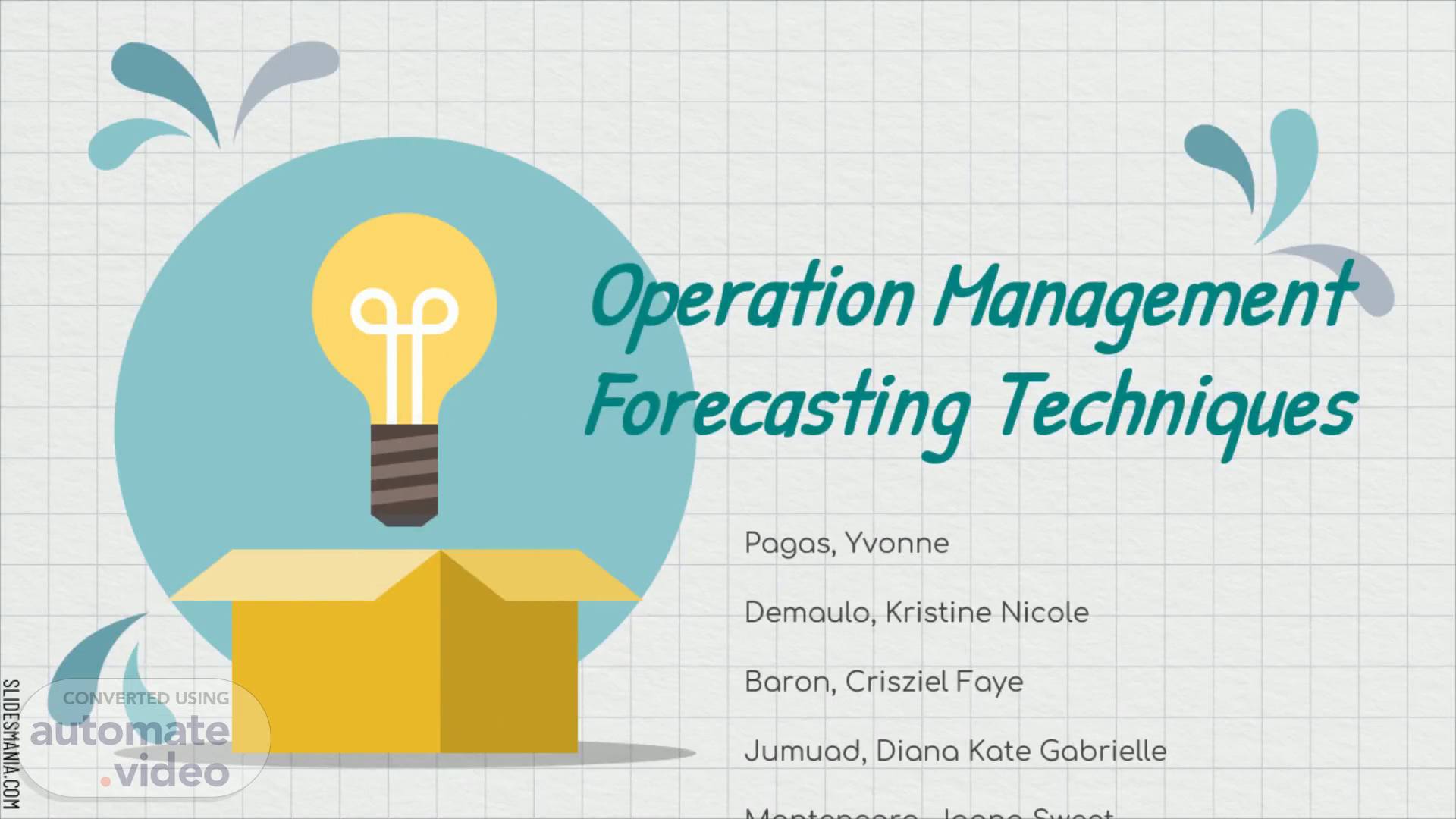
Page 1 (0s)
Operation Management Forecasting Techniques. Pagas , Yvonne Demaulo , Kristine Nicole Baron , Crisziel Faye Jumuad , Diana Kate Gabrielle Montenegro , Joana Sweet.
Page 2 (12s)
Bitmoji Image. Fo recasting. Forecasting is the process of estimating the relevant events of future, based on the analysis of their past and present behaviour..
Page 3 (24s)
?. In preparing plans for the future, the management authority has to make some predictions about what is likely to happen in the future..
Page 4 (36s)
01. On the basis of the definition, the following features of forecasting can be identified:.
Page 5 (48s)
02. Forecasting is needed for planning process because it devises the future course of action..
Page 6 (58s)
03. It defines the probability of happening of future events. Therefore, the happening of future events can be precise only to a certain extent..
Page 7 (1m 10s)
04. Forecasting is made by analysing the past and present factors which are relevant for the functioning of an organisation..
Page 8 (1m 21s)
0 5. The analysis of various factors may require the use of statistical and mathematical tools and techniques..
Page 9 (1m 31s)
Role of Forecasting. Since planning involves the future, no usable plan can be made unless the manager is able to take all possible future events into account..
Page 10 (1m 44s)
Forecasting is the key to planning. It generates the planning process..
Page 11 (1m 55s)
ONINNV7d. FORECASTING. Planning.
Page 12 (2m 3s)
The objectives of an organisation are achieved through the performance of certain activities..
Page 13 (2m 14s)
Forecasting indirectly provides the way for effective co-ordination and control ..
Page 14 (2m 25s)
All business enterprises are characterised by risk and have to work within the ups and downs of the industry..
Page 15 (2m 37s)
The process of forecasting generally involves the following steps:.
Page 16 (2m 46s)
Developing the Basis. Estimating Future Operations.
Page 17 (2m 58s)
1. Developing the Basis:. The future estimates of various business operations will have to be based on the results obtainable through systematic investigation of the economy, products and industry..
Page 18 (3m 12s)
2. Estimation of Future Operations. On the basis of the data collected through systematic investigation into the economy and industry situation, the manager has to prepare quantitative estimates of the future scale of business operations..
Page 19 (3m 27s)
3. Regulation of Forecasts. It has already been indicated that the managers cannot take it easy after they have formulated a business forecast..
Page 20 (3m 39s)
4. Review of the Forecasting Process. Having determined the deviations of the actual performances from the positions forecast by the managers, it will be necessary to examine the procedures adopted for the purpose so that improvements can be made in the method of forecasting..
Page 21 (3m 56s)
Techniques of Forecasting. There are various methods of forecasting. However, no method can be suggested as universally applicable. In fact, most of the forecasts are done by combining various methods..
Page 22 (4m 9s)
A brief discussion of the major forecasting methods is given below:.
Page 23 (4m 19s)
1. Historical Analogy Method. Under this method, forecast in regard to a particular situation is based on some analogous conditions elsewhere in the past..
Page 24 (4m 31s)
2. Survey Method. Surveys can be conducted to gather information on the intentions of the concerned people..
Page 25 (4m 43s)
3. Opinion Poll. Opinion poll is conducted to assess the opinion of the experienced persons and experts in the particular field whose views carry a lot of weight..
Page 26 (4m 56s)
4. Business Barometers. A barometer is used to measure the atmospheric pressure. In the same way, index numbers are used to measure the state of an economy between two or more periods..
Page 27 (5m 10s)
5. Time Series Analysis. Time series analysis involves decomposition of historical series into its various components, viz. trend, seasonal variances, cyclical variations, and random variances..
Page 28 (5m 24s)
6. Regression Analysis. Regression analysis is meant to disclose the relative movements of two or more inter-related series..
Page 29 (5m 35s)
7. Input-Output Analysis. According to this method, a forecast of output is based on given input if relationship between input and output is known..
Page 30 (5m 48s)
The basis of this technique is that the various sectors of economy are interrelated and such inter-relationships are well-established..
Page 32 (6m 7s)
Carlos V.. Mariel S.. Oscar M..
Page 33 (6m 16s)
Showcase places. 100% Editable.